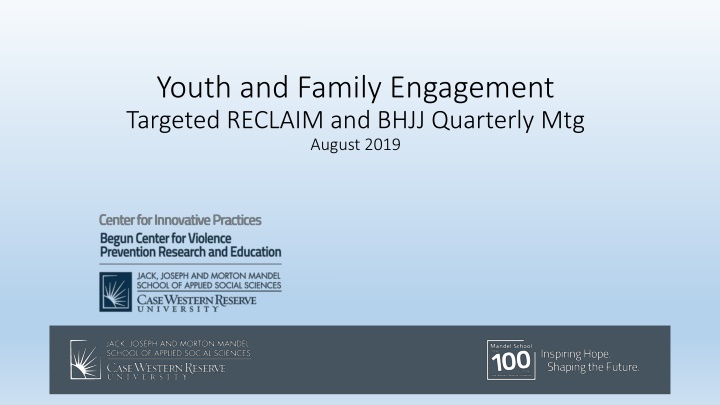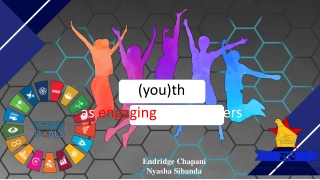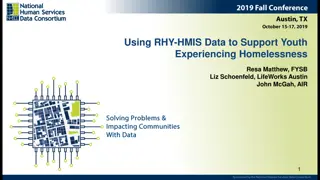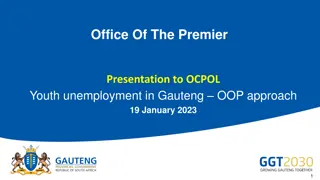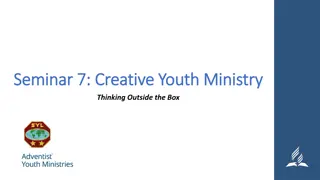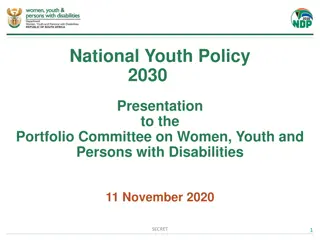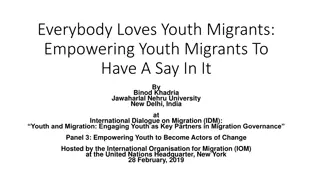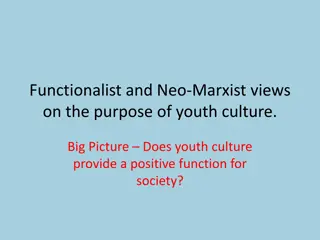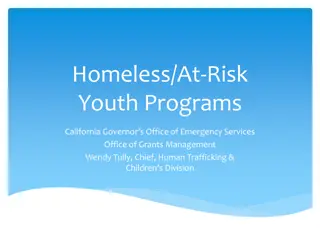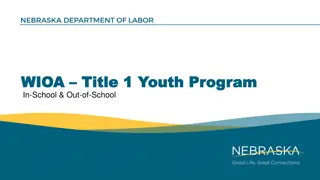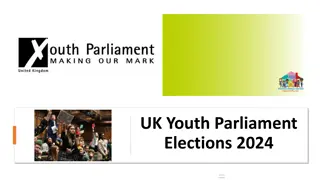Youth and Family Engagement in Treatment Context
Engagement in youth and family treatment is pivotal for successful outcomes. It involves more than just attendance, encompassing behavioral and attitudinal factors that contribute to building a therapeutic alliance. Systemic and multilayered approaches are essential for effective engagement in multi-stressed environments, considering factors like provider engagement, cultural understanding, and family readiness to engage.
Download Presentation

Please find below an Image/Link to download the presentation.
The content on the website is provided AS IS for your information and personal use only. It may not be sold, licensed, or shared on other websites without obtaining consent from the author.If you encounter any issues during the download, it is possible that the publisher has removed the file from their server.
You are allowed to download the files provided on this website for personal or commercial use, subject to the condition that they are used lawfully. All files are the property of their respective owners.
The content on the website is provided AS IS for your information and personal use only. It may not be sold, licensed, or shared on other websites without obtaining consent from the author.
E N D
Presentation Transcript
Youth and Family Engagement Targeted RECLAIM and BHJJ Quarterly Mtg August 2019
What defines engagement? Attendance: the most common measurement can t have treatment without it can t achieve or measure outcomes without it Staudt (2007) differentiated Behavioral and Attitudinal Engagement: Behavioral: attendance, client behaviors such as talking, homework completion Attitudinal: emotional investment and commitment to treatment But just showing-up still isn t enough
Engagement Engagement is built on the construction of a therapeutic alliance In 1979, Bordin noted that the therapeutic alliance includes 3 components: 1. agreement on goals 2. establishing tasks 3. building a bond Without this alliance, therapy has a greater chance of premature termination Thompson et al, 2007
Engagement is Engagement is Systemic Systemic Youth and family engagement and treatment receptivity occurs in context and interacts with: Quality of provider engagement; Perceived provider clinical credibility and helpfulness of the service Perceived cultural understanding of their family; Perceived trustworthiness of the provider and the system; and, The level of family service burden and burnout Mutual Assessment Process: Families and youth are assessing you while you are assessing them
Engagement is Multilayered Unlocking multiple locks on a door Build relationships with all family members Respect for family culture and values Understanding the family system s dynamic Family power differential Respecting the family hierarchy Readiness to engage: Start where the family is at motivationally Family trust Past system trauma System mandates Appreciative perspective of the family s journey
Multi-stressed Environments A multi-stressed environment is one in which children & families are affected over a long period of time by one or more sources of significant stress The sources of stress are routine, un-relenting, & woven into daily life They may be the result of societal conditions & pressures that are beyond the control of individual families By the time services providers get involved so many things may have happened and the family may be overwhelmed, frustrated, discouraged, and hopeless. Some conditions can be so overwhelming it can override our inherent resiliency. Mark Katz National Networking Meeting for Head Start Education Coordinators, November 1990. 6
Supporting Families from a Resiliency-Oriented Perspective Honor family s expertise Appreciative perspective: Families are doing the best they can do, given their current abilities and life circumstances. Validation: The youth and family are validated for their expertise, courage, efforts, and persistence Valuing: Understand and respect the family s unique beliefs, values, customs, languages, abilities, traditions, and life experiences Provide Hope: Foster the possibility of hope and a positive future Hold the hope until the family can hold the hope. 7
Culturally Mindful Engagement Engagement is based on a respectful, supportive, and validating relationship with all family members, that is based on a deep understanding of the family s unique values, culture, life experiences, and perspectives. Respectful humility and cultural mindfulness Assume that you need to earn each family s respect Utilize family s unique values and culture in planning process Understand that youth s peer group culture may have different value set than family s value set Make no value assumptions or judgments about the family
Home-Based Family Engagement Foundations Systems Theory The family is a unit individuals cannot be understood in isolation from one another true change for high-risk youth can only happen within the context of the family. Cornett 2011 Southernsandtray.com
Change in the System Who does Cesar Millan work with to bring about change? *Idea taken from Dr. B Lander of the Ohio State University tvblogs.nationalgeographic.com
The System of System From a family systems perspective, clinical interventions should orchestrate emotional and cognitive change within individuals and interactional changes between family members. www.seasky.org Ozechowski and Liddle, 2000 p.270
Common Engagement Pitfalls Over-engagement- lose your boundaries Aligning with one family member at the expense of other family relationships Saving the child from his or her parents Not joining with the parents Not valuing or taking the time to build relationships with the family s informal support system; not engaging with the entire family system Misinterpreting a family s self-protection as resistance Highly directive or expert therapist, little collaboration
Engagement with mandated families The stressors associated with court involvement negatively strain family emotional, interpersonal, and material resources. Treatment engagement, motivation, and progress are more difficult to attain and sustain. Patient and persistence utilizing multiple engagement strategies is required.
Understanding the drivers of low engagement From the youth and family perspective: There is no problem My child is the one who needs help- not me. We have already had services. They were not helpful. Self protection: the last time you were involved you tried to take my children Relatedly: if we start to take part in this, you will have to start making reports Out of sight out of mind --Our house is more peaceful when he is high/running the streets
Therapeutic Alliance Building A strong therapeutic alliance with each family member will increase each person s commitment to involvement and thereby increase likelihood of decreased risks and better outcomes Each member s perception of clinician: Rapport ability Warmth (maybe the most important to the youth) Optimism Humor Commitment are crucial aspects
Alliance: considerations Elevated family distress strongly interferes with alliance development: Family poverty Single parent families Effectiveness of parental discipline Family cohesion Very critical parents (more negative than praise) Multiple family level problems (perhaps biggest influence for treatment drop- out) Previous negative treatment experience Inadequate family support
Parent: Considerations Baumrind, MST 2nd ed Parenting styles describe the family system Authoritative: high control; high warmth Responsive and reasonable Authoritarian: high control; low warmth Directive and controlling Permissive: low control; high warmth Little structure but responsive Neglectful: low control; low warmth Little discipline and little attention
Parental Alliance Both parents and youth have credited a good alliance with the therapist positively influencing the family alliance. A small study looked at therapists traits rated as helpful for creating and sustaining the therapeutic alliance in family work *Thompson et al, 2007
Traits: Relationship Building Parents valued: Calm and friendly attitude; not rushed Relaxed and willing; willing to sit on the floor Joined with the family; part of the family Neutral and composed demeanor; nonjudgmental Youth valued: felt like I was being listened to
Traits: Task-Centered Parents valued: Learning new skills, especially toward communication and insight toward their teen s behaviors Like direct advice: may benefit from insight that emerges from the process Weekly goals and objectives and (maybe) a bit more structure regarding parent/caregiver sessions.
Traits: Intra-Family Engagement Parents valued: Some percentage enjoyed the weekly time together in task-focused activities with modeled new communication skills, respect and meaningful communication could be explored
Traits: Caution Some parents found the expectations and experience of family therapy to be too intense and too overwhelming limiting or not permitting a therapeutic alliance Varied levels of commitment by various family members can also increase difficulties
Family Engagement: Structural Support In recap: Parents like direction and education Don t like to feel judged or rushed May be more comfortable with weekly goals or objectives Can feel overwhelmed by the multiple areas of concerns Hope Confidence Humor Commitment
Conceptualizing the Process: Family and Parent Engagement Initiation Phase Listening and collaboration Expansion of assessment: ecocontextual map and genogram: Safety Plan Working Phase Match interventions to abilities and readiness Support realistic expectations (and understanding of) for change Utilize IHBT Consult form Transitioning Phase Six weeks out assess family goals/readiness, level of need and search for best fit
Engagement: Lessons Learned Engagement is a relationship-based process that occurs over time Never take engagement for granted Engagement may wax and wane over the course of treatment Do engagement check-ins with the youth and family Loss of engagement can lead to youth and family distancing and lack of progress in therapy Use your supervisor and team consultation process to help you find engagement barriers and solutions
Engagement: From the Field Treatment-description prior to mandated involvement: a one-pager to families describing treatment methods, targets and requirements. Related: brief training coverage of treatment model(s) to system partners: in the juvenile courts, inclusion of judges and magistrates is helpful Contingency Management: supportive, value-based reinforcers (or, in English: gift cards for caregiver and for youth) Budget for food: taking a pizza to a family meeting never underestimate the fundamental human custom of breaking bread together Standing system-partner meetings Scheduled status-review hearing (30 to 45 days out) at the time of referral Support for supportive supports (like respite, peer support, mentoring etc.) As a last (or near-last) resort, clinicians may use treatment contracts ( must attend without any cancellations 5 consecutive appointments on the following dates ), which can be coordinated with Juv Court.
References Cornett, S.M. (2011). Home-Based Services for High-Risk Youth: Assessment, Wraparound Planning, and Service Delivery. Kingston, NJ. Civic Research Institute. Ozechowski TJ, Liddle HA. (2000). Family-based therapy for adolescent drug abuse: Knowns and unknowns. Clinical Child and Family Psychology Review, 3(4), 269-98. Staudt, M. (2007). Treatment engagement with caregivers of at-risk children: Gaps in research and conceptualization. Journal of Child and Family Studies, 16(2), 183-196. http://dx.doi.org/10.1007/s10826-006-9077-2 Thompson, S.J., Bender, K., Lantry, J. et al. (2007). Treatment Engagement: Building Therapeutic Alliance in Home-Based Treatment with Adolescents and Their Families. Contemporary Family Therapy, 29: 39. https://doi.org/10.1007/s10591-007-9030-6 Tsang, A. K. T., Bogo, M., & Lee, E. (2011). Engagement in cross-cultural clinical practice: Narrative analysis of first sessions. Clinical Social Work Journal, 39(1), 79-90. http://dx.doi.org/10.1007/s10615-010-0265-6 Also as noted in slides
